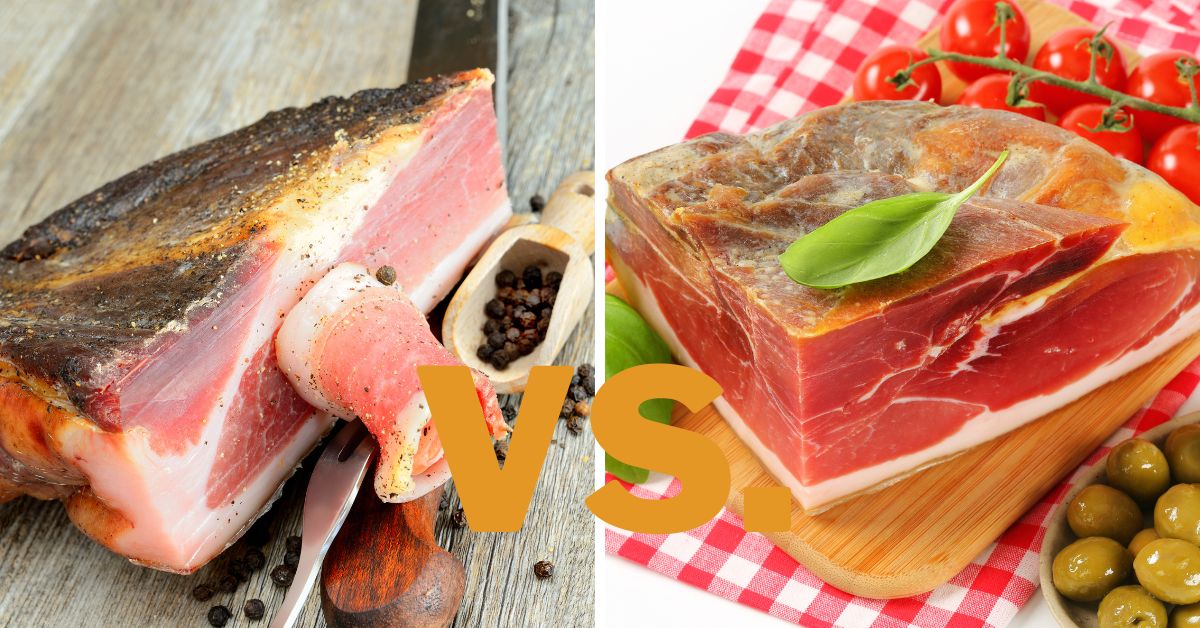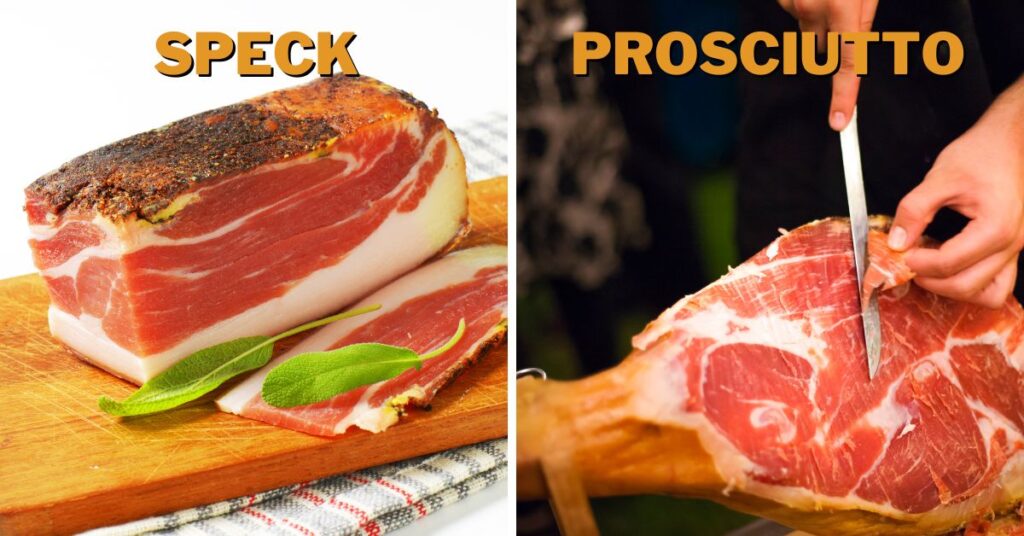Speck vs. Prosciutto: Differences & Which Is Better?

Beloved by many and known worldwide, speck and prosciutto have become synonymous with elegance. Many cannot differentiate between these two delicacies, and justifiably so, they are indeed very similar. Still, despite their many similarities, prosciutto and speck aren’t the same product. So, what are the differences between prosciutto and speck, and which is better?
Both are made from the same body part- the pig’s hind leg; they are both salted, seasoned, and cured. The main difference is that speck is smoked, while prosciutto is not. The spice blend for prosciutto is usually salt and pepper, and for speck, it often contains bay leaves and other spices.
Unless you are a huge cured meat fan and have a trained palate, chances are, prosciutto and speck will taste the same to you. However, both types of meat require much time, effort, and skill, so it would be a shame not to appreciate them for what they are. Therefore, in the following text, I will explain the differences between prosciutto and speck, I will discuss their similarities, and explain the substituting options.
Speck vs. Prosciutto: Differences
Speck and prosciutto share many similarities. They are both Italian; Speck originated in South Tyrol, while Parma is most famous for its prosciutto. Since South Tyrol was under German and Austrian influence, “speck” is the German name for bacon, hence the common misconception.
Although similar in many aspects, speck and prosciutto are still two different kinds of cured meats.
Origins
Speck originated in South Tyrol in the 15th century. This area was under strong German and Austrian influence, which is why the word has a German origin and means “bacon.”
Prosciutto is believed to be as old as time. The meat preserving technique used for prosciutto originated as early as 100 BC and was applied by the Romans.
Ingredients and Preparation
Speck and prosciutto undergo a very similar production process, with speck having an additional step until the final product is obtained.
Speck and prosciutto come from the same part- the pig’s hind leg. The first step of the production process for both is to clean the meat. Then, the meat is seasoned with a substantial amount of salt to prevent meat-eating bacteria from appearing.
After it has been cleaned and salted, the meat is then left to cure. The longer the curing takes, the drier the meat will be—the drier the meat, the more intense the taste.
The success of the curing depends on the conditions in which the meat was cured. Whether or not the room was dry, and the percentage of humidity and light. Therefore, this stage of the production process of speck and prosciutto is crucial, and it isn’t as simple as you may think.
The curing conditions need to be just right because the slightest misalignment between what the meat needs and what it surrounds can cause it to spoil. This is one of the reasons speck and prosciutto are so delicate and pricy.
The curing is the final stage of the prosciutto production process. The length of the curing process depends on the desired taste, but it isn’t supposed to be shorter than nine months. The Prosciutto di Parma intended for the US market needs to be cured for at least 400 days.
While the prosciutto production process ends with the curing, the speck’s production process has one more step: smoking the meat. Therefore, speck is considerably drier than prosciutto, especially since after the smoking, the meat needs to dry for additional 22 weeks.
As for the seasoning, both prosciutto and speck are salted with large amounts of salts so as to prevent the mean from going bad. In addition to salt, prosciutto is often seasoned with black pepper, whereas the speck seasoning is more extensive. The seasoning blend for speck often contains bay leaves and juniper berries, and the blend mostly depends on who is making the speck, as many spice blends are considered a secret and a part of a family recipe.

Taste
Both prosciutto and speck taste absolutely delicious and are very distinctive. You may think that speck is prosciutto and vice versa, but you absolutely can’t mistake either of the two with another delicacy.
Prosciutto and speck are both expressively salty, although the salt amount is limited to 2% for both; however, salty isn’t the only flavor. The drier the prosciutto, the more intense the flavor, so you’ll feel a slight bitterness, saltiness, fattiness, and mild sweetness. Depending on the spices, it can also feel like garlic if garlic is part of the seasoning and mildly herbal.
Although dry, prosciutto is stacked with fat. Each slice is smooth and greasy, and very satiating. It has a salmon-red color, darker on the surface and brighter and lighter towards the middle.
Speck is stronger-tasting than prosciutto due to the blend of spices used to season the meat. Because of the smoking process, speck has a dim but very noticeable smoky flavor and is drier than prosciutto. However, the speck is still greasy and fatty.
Speck’s color is significantly darker than prosciutto’s. It’s more of a dark purple color in the middle with an even darker shade on the outside.
Nutrition
Since both prosciutto and speck come from the same part of the pig and are similarly made, they have the same nutritional values. The smoking of the speck does not impact the nutritional value, and its only results are the taste, smell, and color.
Prosciutto and speck are both very fatty and caloric. They contain a significant amount of cholesterol. They are shy in nutrients, and aside from the sodium and potassium, they don’t have much else to offer. [1]
However, they contain reasonable protein amounts.
Serving Styles
Prosciutto and speck are intended to have as a cold entrée or something to nibble on combined with other products such as cheeses, nuts, and dried fruits, and they aren’t meant to be used as an ingredient in another dish.
However, they are many types of warm sandwiches containing prosciutto and speck. Still, the prosciutto and speck haven’t been cooked but just pressed on a hot place long while inside the sandwich.
Another place where prosciutto and speck are used is as a pizza topping. However, they are cooked on the pizza for just a few minutes, just enough to mix with the sauces and cheeses.
There are also types of pasta containing prosciutto and speck, but again, they are thrown in the sauce shortly before removing the sauce from the stove.
In general, prosciutto and speck are intended to have as they are, as they don’t cook well. If you still want to experiment with cooking them, make sure that it is very short and it involves baking or sizzling.
Can You Substitute Speck with Prosciutto?
Served as they are, without cooking them, you can substitute speck with prosciutto anytime. They are both greasy and delicious and go with the same ingredients.
If you want to cook them, you cannot substitute speck with prosciutto that easily, as you’ll need to modify the recipe in terms of length of cooking and shorten the cooking time.
Can You Substitute Prosciutto with Speck?
Yes, you can substitute prosciutto with speck, but be prepared that the taste will be stronger and smoky, which is not a bad thing, but it’s not what you came for if you want prosciutto.
If you intend on cooking it, you’ll need to adjust the time and recipe.
Can You Substitute Speck for Bacon?
It is very common to regard speck as bacon, so yes, you can substitute speck for bacon. There is such a thing as smoked bacon, so speck will easily fit into this equation. While speck comes from the hind of the pig’s leg, bacon comes from the belly, so you might notice that bacon is fattier than a speck.
